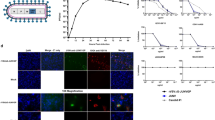Abstract
Various strategies for the production of safe vaccines have been used. This study compared three different inactivation procedures, i.e. treatment with formaldehyde, β-propiolactone or UV-light using vesicular stomatitis virus (VSV) as a model antigen. All three inactivation procedures drastically impaired induction of neutralizing IgG responses, confirming previous observations [Bachmann et al. (1993) J Virol 67:3917–3922]. This reduction could be overcome using higher doses for all three preparations. Both formaldehyde and β-propiolactone completely abrogated the induction of VSV-specific cytotoxic T cells (CTLs), whereas UV-inactivated virus was able to induce significant and long-lasting CTL responses. These results may be of practical relevance since induction of neutralizing antibodies alone is often not sufficient for protection and sometimes may even enhance immunopathological responses of vaccinees.
Similar content being viewed by others
References
Bachmann MF, Kündig TM, Kalberer C, Hengartner H, Zinkernagel RM (1993) Formalin inactivation of vesicular stomatitis virus impairs T cell- but not T help-independent B cell responses. J Virol 67:3917–3922
Battegay M, Kyburz D, Hengartner H, Zinkernagel RM (1993) Enhancement of disease by neutralizing antiviral antibodies in the absence of primed antiviral cytotoxic T cells. Eur J Immunol 23:3236–3241
Charan S, Zinkernagel RM (1986) Antibody mediated suppression of secondary IgM response in nude mice against vesicular stomatitis virus. J Immunol 136:3057–3061
Connors M, Kulkarni AB, Firestone C-Y, Holmes KL, Morse HC III, Sotnikov AV, Murphy BR (1992) Pulmonary histopathology induced by respiratory syncytial virus (RSV) challenge of formalin-inactivated RSV-immunized BALB/c mice is abrogated by depletion of CD4+ T cells. J Virol 66:7444–7451
Corapi WV, Olsen CW, Scott FW (1992) Monoclonal antibody analysis of neutralization and antibody-dependent enhancement of feline infectious peritonitis virus. J Virol 66:6695–6705
Fenner F, McAuslan BR, Mims CA, Sambrook J, White DO (1974) The biology of animal viruses. Academic Press, New York
Fulginiti VA, Eller JJ, Downie AW, Kempe CH (1967) Altered reactivity to measles virus: a typical measles in children previously immunized with inactivated measles virus vaccine. JAMA, 202:1075–1080
Halstead SB (1988) The thesis that won't go away. Nature 331:497–498
Halstead SB (1988) Pathogenesis of dengue: challenges to molecular biology. Science 239:476–481
Horstmann DM (1979) Viral vaccines and their ways. Rev Infect Dis 1:502–516
Horstmann DM (1982) Control of poliomyelitis: a continuing paradox. J infect Dis 146:540–551
Kapikian AZ, Mitchell RH, Chanock RM, Shvedoff RA, Stewart CE (1969) An epidemiologic study of altered clinical reactivity to respiratory syncytial (RS) virus infection in children previously vaccinated with an inactivated RS virus vaccine. Am J Epidemiol 89:405–421
Kelley JM, Emerson SU, Wagner RR (1972) The glycoprotein of vesicular stomatitis virus is the antigen that gives rise to and reacts with neutralizing antibodies. J Virol 10:1231–1235
Le Grand R, Vaslin B, Vogt G, Roques P, Humbert M., Dormont (1992) AIDS vaccine developments. Nature 355:684
Leist TP, Cobbold SP, Waldmann H, Aguet M, Zinkernagel RM (1987) Functional analysis of T lymphocyte subsets in antiviral host defense. J Immunol 138:2278–2281
McCaren LC, Holland JJ, Syverton JT (1959) The mammalian cell-virus relationship. I. attachment of poliovirus to cultivated cells of primate and non-primate origin. J Exp Med 109:475–485
Meyer HM Jr, Hopps HE, Parkman PD, Ennis FA (1978) Review of existing vaccines for influenza. Am J Clin Pathol 70:146–152
Nkowane BM, Wassilak SG, Orenstein WA (1987) Vaccine-associated paralytic poliomyelitis in the United States: 1973 through 1984. JAMA 257:1335–1340
Okada Y, Takokoro J (1962) Analysis of giant polynuclear cell formation caused by HVJ virus from Ehrlich's ascites tumor cells. II. Quantitative analysis of giant polynuclear cell formation. Exp Cell Res 26:168
Paul WE (1989) Fundamental immunology. Raven Press, New York
Prince GA, Jenson AB, Hemming VG, Murphy BR, Walsh EE, Horswood RL, Chanock RM (1986) Enhancement of respiratory syncytial virus pulmonary pathology in cotton rats by prior intramuscular inoculation of formalin-inactivated virus. J Virol 57:721–728
Puddington L, Bevan MJ, Lefrancois L (1986) N protein is the predominant antigen recognized by vesicular stomatitis virus-specific cytotoxic T cells. J Virol 60:708–717
Roscoe DM, Ishikawa K, Lyles DS (1991) Role of de novo protein synthesis in target cells recognized by cytotoxic T lymphocytes specific for vesicular stomatitis virus. J Virol 65:6856–6861
Rosenthal KL, Zinkernagel RM (1980) Cross-reactive cytotoxic T cells to serologically distinct vesicular stomatitis viruses. J Immunol 124:2301–2308
Sabin AB (1985) Oral poliovirus vaccine: history of its development and use and current challenge to eliminate poliomyelitis from the world. J infect Dis 151:420–436
Salk J, Salk D (1977) Control of influenza and poliomyelitis with killed virus vaccines. Science 195:834–847
Scott DW, Gershon RK (1970) Determination of total and mercaptoethanol-resistant antibody in the serum sample. Clin Exp Immunol 6:13–18
Van Bleek GM, Nathenson SG (1990) Isolation of an endogenously processed immunodominant viral peptide from the class I H-2Kb molecule. Nature 348:213–216
Vennema H, De Groot RJ, Harbour DA, Dalderup M, Gruffydd-Jones T, Horzinek MC, Spaan WJM (1990) Early death after feline infectious peritonitis virus challenge due to recombinant vaccinia virus immunization. J Virol 64:1407–1409
Wagner RR (1987) The rhabdoviruses. Plenum Press, New York
Yewdell JW, Bennink JR, Mackett M, Lefrançois L, Lyles DS, Moss B (1986) Recognition of cloned vesicular stomatitis virus internal and external gene products by cytotoxic T lymphocytes. J Exp Med 163:1529–1538
Author information
Authors and Affiliations
Rights and permissions
About this article
Cite this article
Bachmann, M.F., Bast, C., Hengartner, H. et al. Immunogenicity of a viral model vaccine after different inactivation procedures. Med Microbiol Immunol 183, 95–104 (1994). https://doi.org/10.1007/BF00277160
Issue Date:
DOI: https://doi.org/10.1007/BF00277160




